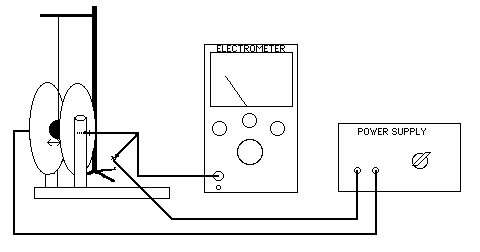Difference between revisions of "Current: Transfer of Charge (Visible Resistor)"
From UO Physics Demonstration Catalog
(Created page with "{{NewDemo|subject=Electricity and Magnetism|topic=Resistance, EMF, and Current|file1=VisibleResistor.gif}} The parallel-plate capacitor is connected to a high-voltage power supply with the electrometer connected in series to monitor the current (10 microamps). A ping-pong ball covered with conductive paint dangles between the two plates. When the power supply is turned on, the ball oscillates between the two plates, transferring charge. The higher the voltage or the clo...") |
|||
| Line 1: | Line 1: | ||
{{NewDemo|subject=Electricity and Magnetism|topic=Resistance, EMF, and Current|file1=VisibleResistor.gif}} | {{NewDemo|subject=Electricity and Magnetism|topic=Resistance, EMF, and Current|file1=VisibleResistor.gif}} | ||
The parallel-plate capacitor is connected to a high-voltage power supply with the | The parallel-plate capacitor is connected to a high-voltage power supply with the Keithly Electrometer connected in series between the negative terminal and one of the capacitor plates. and set-up to measure current (10 microamps). A ping-pong ball covered with conductive paint dangles between the two plates. When the power supply is turned on, the ball oscillates between the two plates, transferring charge. The higher the voltage or the closer the two plates, the faster the ball will travel between the plates, therefore transferring charge at a higher rate, which means there is a higher current (However, this is not a linear system). | ||
'''Location: | '''Location: | ||
''' | ''' | ||
* Parallel-plate Capacitor: Shelf I-2 | * Parallel-plate Capacitor: Shelf I-2 | ||
* | * Electrometer Shelf K-2 | ||
* Power Supply: Shelf K-3 | * Power Supply: Shelf K-3 | ||
* Ball: Drawer 62 | * Ball: Drawer 62 | ||
* | * | ||
Revision as of 17:22, 15 January 2023
Return to Resistance, EMF, and Current
Description:
The parallel-plate capacitor is connected to a high-voltage power supply with the Keithly Electrometer connected in series between the negative terminal and one of the capacitor plates. and set-up to measure current (10 microamps). A ping-pong ball covered with conductive paint dangles between the two plates. When the power supply is turned on, the ball oscillates between the two plates, transferring charge. The higher the voltage or the closer the two plates, the faster the ball will travel between the plates, therefore transferring charge at a higher rate, which means there is a higher current (However, this is not a linear system).
Location:
- Parallel-plate Capacitor: Shelf I-2
- Electrometer Shelf K-2
- Power Supply: Shelf K-3
- Ball: Drawer 62
